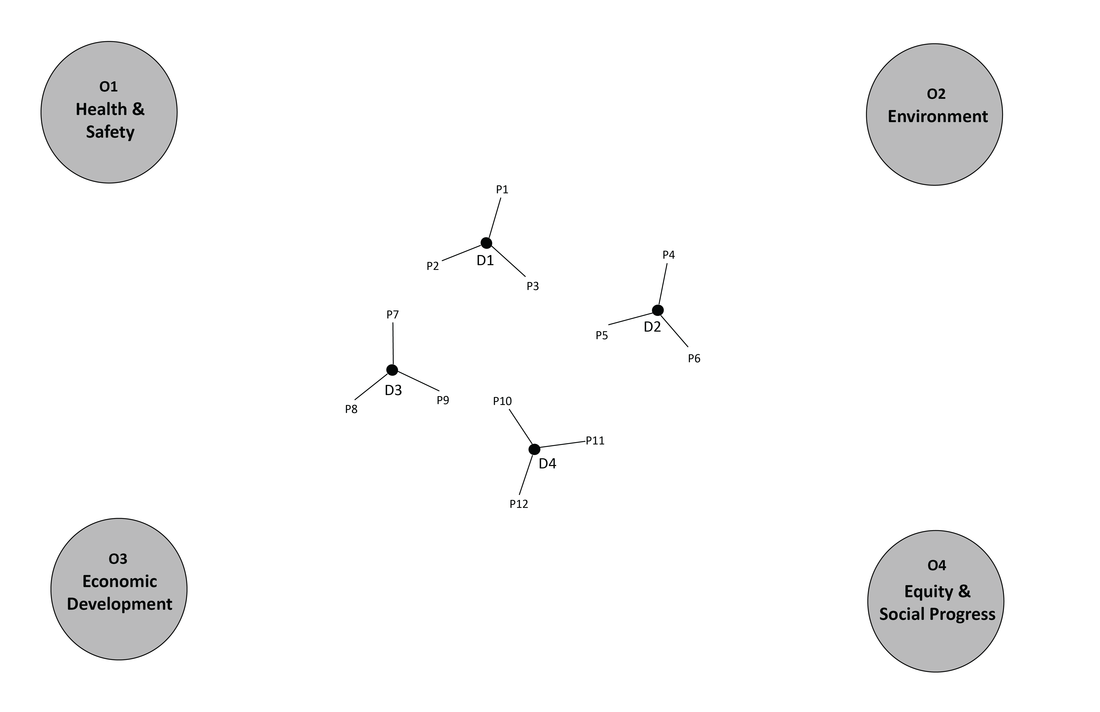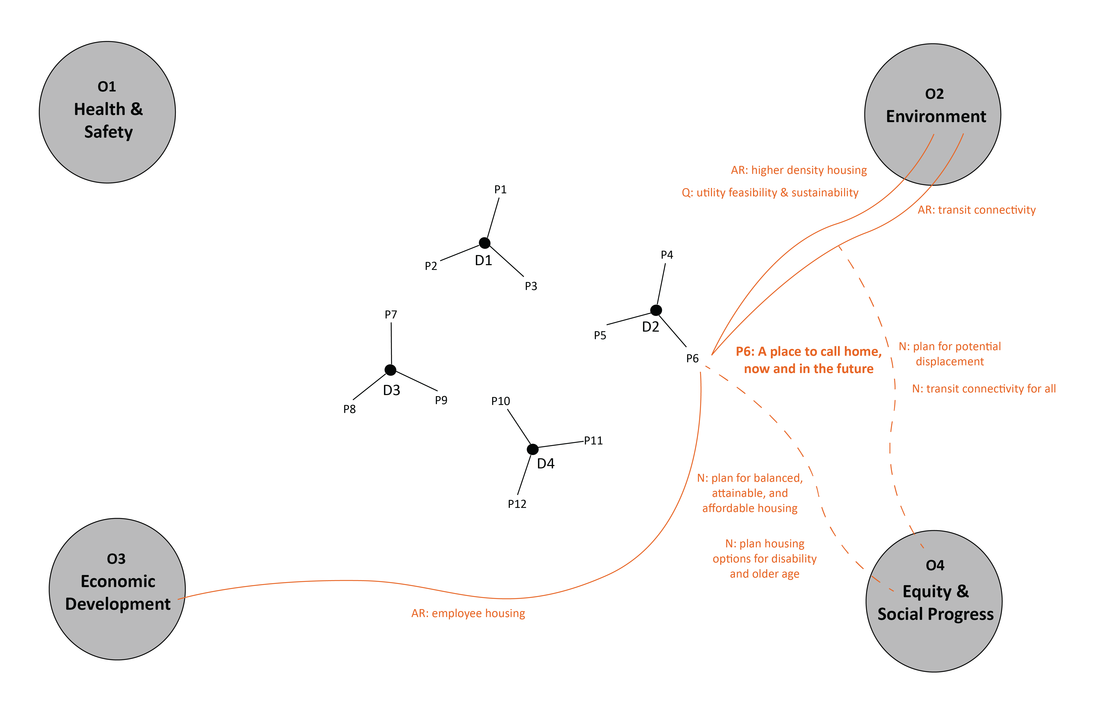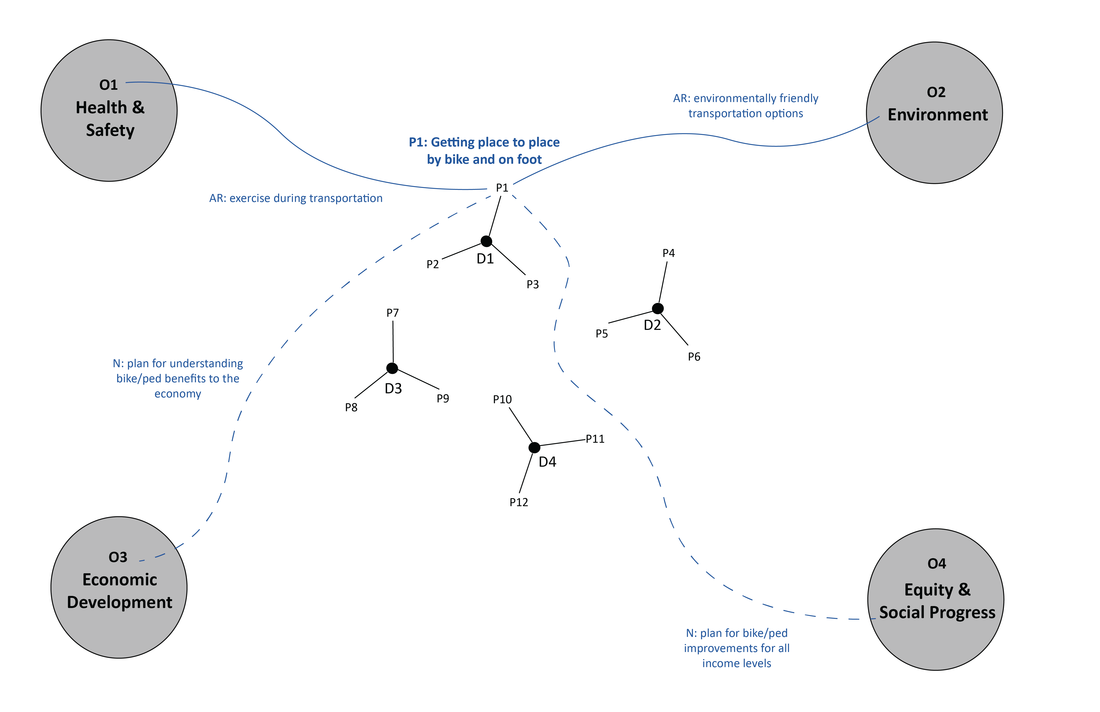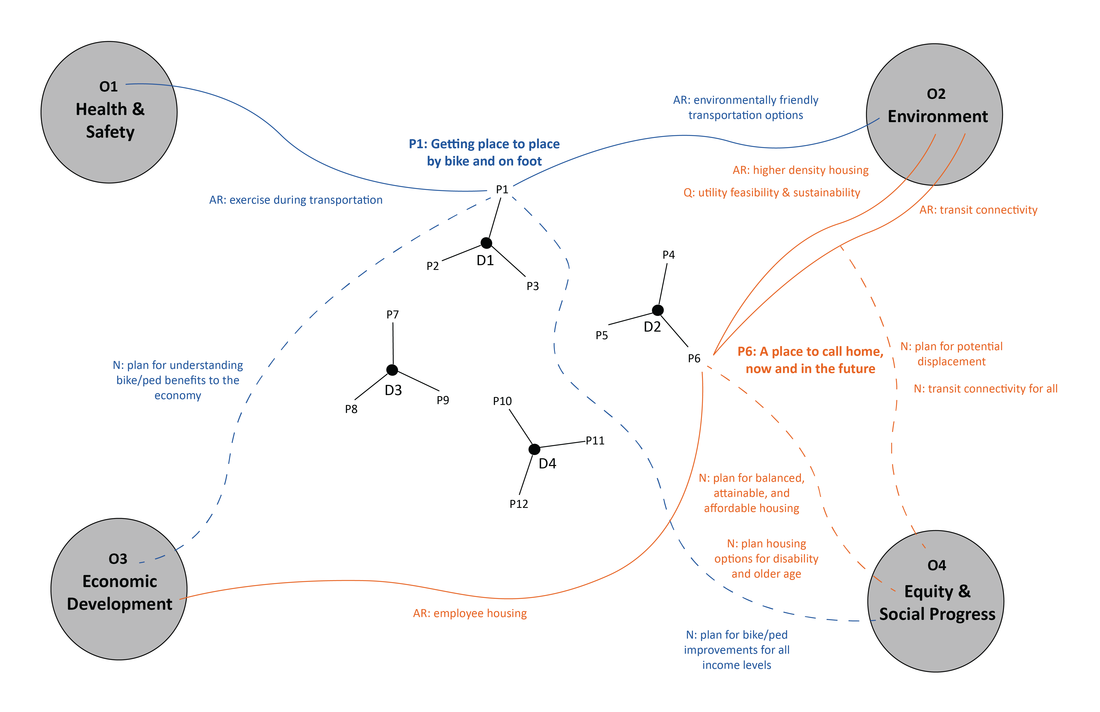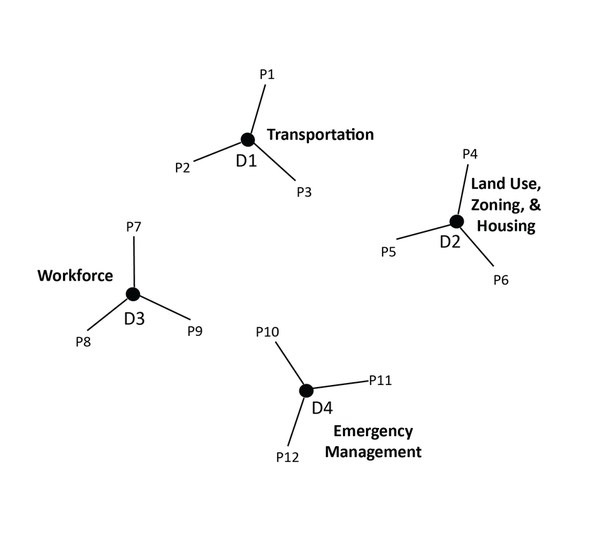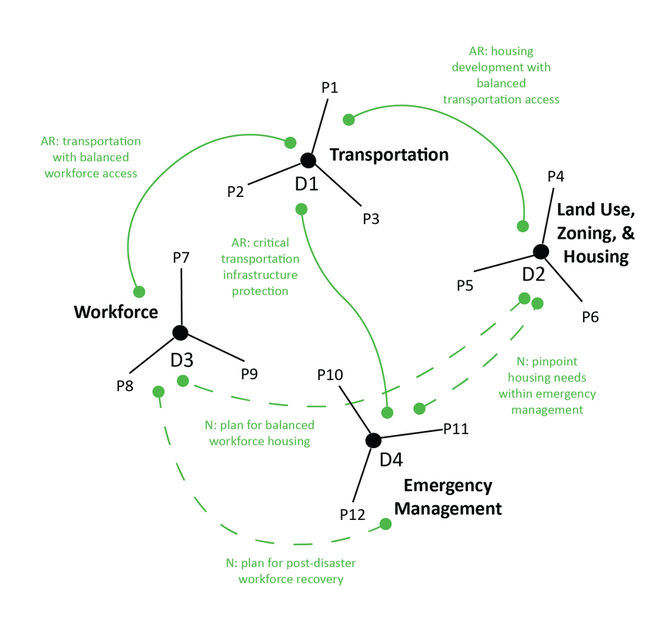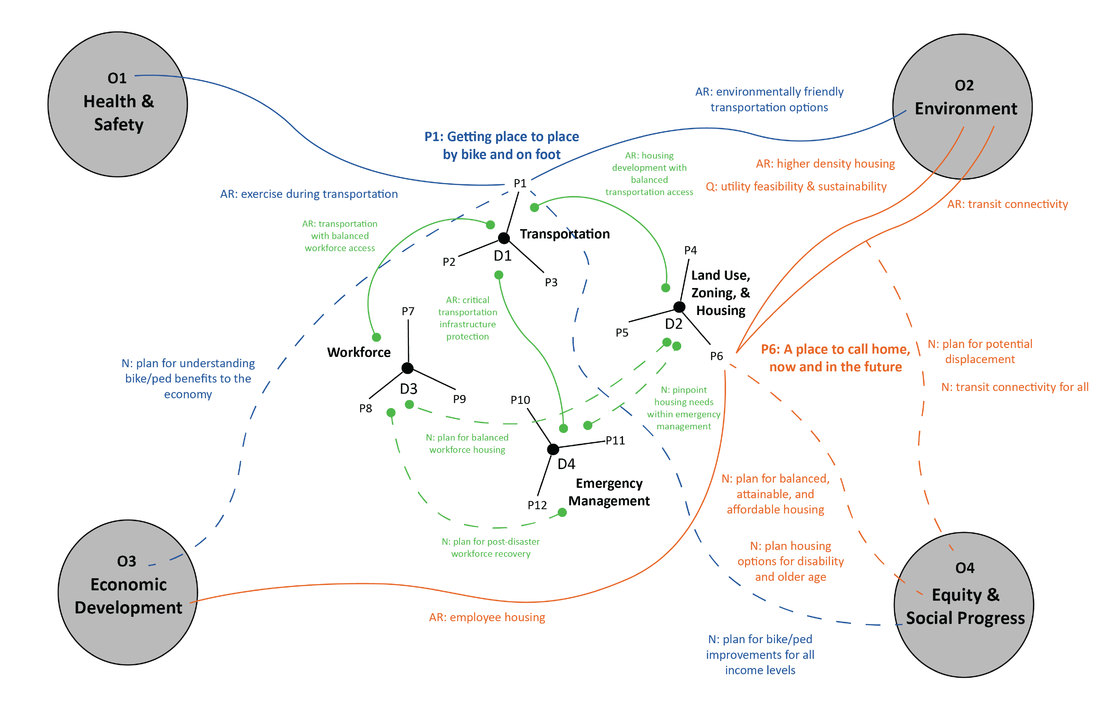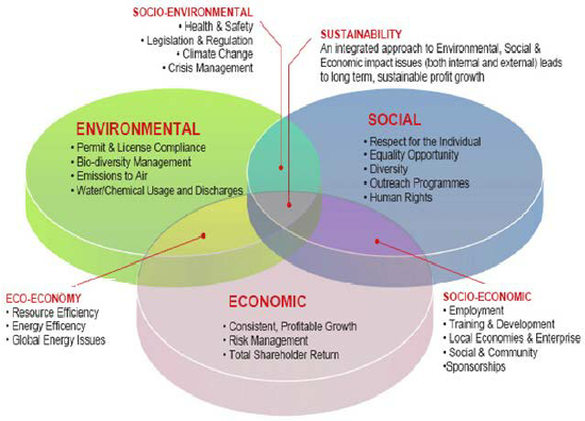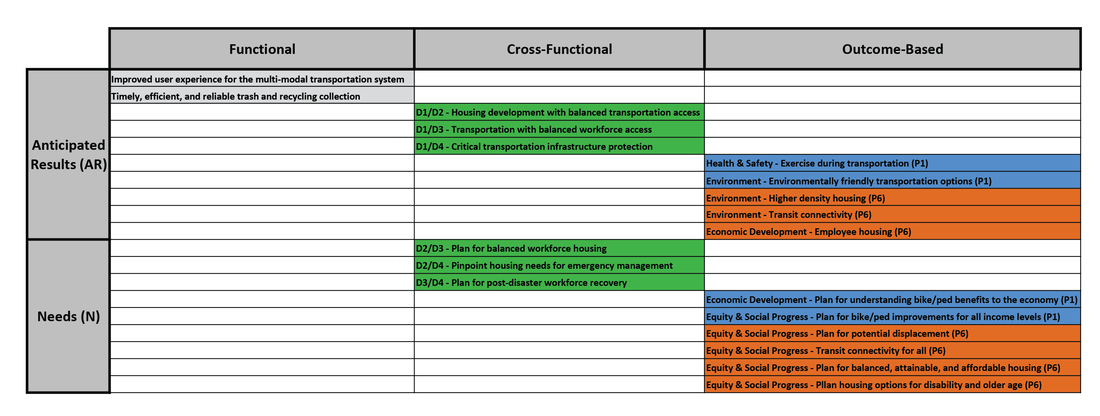How to Map for OutcomesMind mapping can help you create a visual depiction of interconnections, to extract from your brain how you see concepts and subjects connect." Why Urban Management Silos Exist covers the basics of silos. But what can be done about silos, or if not the silos themselves, then “siloed thinking?” The opposite of siloed thinking is 360 Degree Planning which means the professional looks at all angles to understand interconnectivity and interdependency, not only for a deeper level of understanding, but also to seed future actions taking this information into account. Let’s say you are on the executive team or head of a division or department of your organization. Departments and divisions tend to be labeled according to their subject area, such as transportation, emergency management, and others. If you are on the executive team and oversee work across many different departments, it could be that lately you’ve realized you are not easily able to communicate the “why” of the organization. You know it contributes to outcomes such as economic development, equity and social progress, health and safety, and environment, but you are not sure how exactly. How can you present the organization’s work in such a way it resonates with the audience and rises above the basics? Perhaps eventually, you even want to be able to measure programs according to various outcomes, such as those listed above. It could also be that the organization is considering focusing its work more on a specific outcome, take equity and social progress for example, and you’d like to see the current status and reveal some initial gaps. Mapping this out is a great place to begin. Note that you can read more about this application of the term “outcomes” in How to Combine Mapping and Results for Holistic Organizations. Why mind mapping? Mind mapping can help you create a visual depiction of interconnections, to extract from your brain how you see concepts and subjects connect. Further, in most cases for urban management, multiple professionals need to work together and agree on how things work and what to do to make them better. Mind mapping as a group can be an amazing way to illustrate what everyone thinks, and how it paints a full picture. Keep in mind, the examples in this and other articles are fairly simplistic intentionally to show the process without getting too “into the weeds.” They are kept general for a wide audience; it is your experience and your mind map that will show you how you see reality. Whatever the reason, mind mapping is a great place to start pinpointing connections. In order to mind map, you only need a pen, paper, and your thinking cap. There are a number of mind mapping software options out there, which a quick online search will reveal. For now, I’ll cover the basics completed by hand. Let’s get mapping! Mind mapping for outcomes step-by-step First, you’ll start off with the current basis of the organization, typically the departments or divisions of the organization. You’ll map these fairly equidistant from each other to give space around each one. Second, you’ll branch from the departments or divisions with the work they produce (see Figure A, D = department, P = Program). There is a wide variety, of course, but typically these are structured as programs (containing multiple projects and initiatives). Note that projects are likely at too small a scale to map with this step, unless they have an importance level similar to a program. Third, you’ll map out the outcomes of focus or interest. These will be to the left and right of the main map to give them some space (see Figure B, O = Outcome). Make copies of the map at this point, if working by hand. You’ll want one copy for each program or initiative. If working in a software program, you’ll want to create a layer for each program or initiative with its name identified for tracking purposes. I’m using a graphics program, so that the images are as clear as possible. Fourth, you’ll begin detailing the map for a specific program or initiative. Let’s take an organization that works on housing needs, and potentially other topics, and let’s say they have an initiative to analyze population projections and the current housing stock in order to estimate the amount of housing needed for the future. They may work on the regional or metro area wide scale and share this information with local governments, or they may be on the local government level and use it for their internal purposes. It influences zoning, incentives for housing development (on state and federal levels), and communication with real estate developers on the level of need. Three staff members work on this initiative, and it is called “a place to call home, now and in the future.” Mapping your first program Now, let’s map “a place to call home, now and in the future” as if you are one of the staff members (see Figure C). The first outcome you think is already strongly connected is economic development. There have been new employers in the area and existing employers scaling up their operations, all with implications for housing employees. You jot down a description to that effect and title it “employee housing” to reflect an anticipated result (AR) of the program. Note that you can read more about “anticipated results” in How to Combine Mapping and Results for Holistic Organizations as well as in the section below. Next, you draw a line to the environmental outcome. This one is about the density of housing. It turns out the new housing proposed would be at a higher density than in the past, using land more efficiently. You title this AR connection “higher density housing.” Another thought comes to mind; can the utility providers keep up with higher density areas? You make a note to speak with utility organizations, water, gas, electricity, and internet service providers, to understand if there are limitations to take into account. Below the AR, a question (Q) is mentioned, “utility feasibility & sustainability.” Another line is drawn to the environmental outcome to highlight that the housing is planned to be transit connected for access to employment and commercial centers. This AR is titled “transit connectivity.” This item sparks a related thought. On past projects, sometimes the transit-connected neighborhoods end up being in such high demand that property values increase and rents rise, which leads to long-time residents moving from the area (i.e., geographic displacement/gentrification). A dashed line is drawn from the “transit connectivity” AR over to the equity and social progress outcome and is titled “plan for potential displacement,” which is labeled as a need (N). In addition, “transit connectivity for all” is added to reflect the need (N) for all income and housing groups to benefit. You wonder if there are protective policies to put in place early on in the effort to counteract this trend, should it occur. After thinking more about equity, you realize that no formal recommendations have been made regarding the balance of housing for various income levels, though it has been discussed. You decide more work is needed in this area and label the need (N) with a dashed line “plan for balanced, attainable, and affordable housing.” Along the same connection, “plan housing options for disability and older age” as an N is added. Mapping your second program The next program you tackle is the bicycle and pedestrian planning and implementation program. It is called “Getting place to place by bike and on foot” (see Figure D). The first line is drawn to the health outcome and titled “exercise during transportation” to describe the role of active transportation options in gaining more exercise, improving overall health, and reducing the likelihood for obesity and related health conditions as an AR. The next line is drawn to the environmental outcome and titled “environmentally friendly transportation options” to address the fact that these options have no related pollutants that impact air quality and climate change as an AR. A dashed line is drawn to equity with the title “plan for bike/ped improvements for all income levels.” In some of the lower income neighborhoods, it is well known that the bike and ped infrastructure is in worse condition than the wealthier neighborhoods; planning for this is an N. Another dashed line connects to the economic development outcome with the title “plan for understanding bike/ped benefits to the economy.” You are confident there is a connection, but not sure what it is exactly. You plan to address this later, also an N. Anticipated results, needs, and questions You see how the map begins to form and take shape. After building out all the layers and comparing them to each other, it becomes clear where the current concentrations of anticipated results (AR) are, in connection with outcomes, as well as where gaps are reflected as needs (N). The ARs provide clear targets, which can be coupled with more detailed qualitative and quantitative measurement of specific tactics, to help compare and contrast different aspects of the program according how they “score." This enables clear target setting through a methodical systems-wide approach. An AR accompanied with a question (Q) let’s you know that more research is needed. While the AR may be a good target, there could be some underlying issue that needs to be better understood. A need (N) identifies something that is crucial to a specific issue that is currently lacking. This means that while a general connection with the outcome is clear, the actual AR that connects the program with the outcome is not defined yet. A separate analysis should be undertaken to identify the ARs to pursue; you ultimately want to convert each N to an AR or multiple ARs. You can see both programs mapped together (see Figure E). How you could use these insights
Once the drafts have been created, if working with pen and paper, one big map can be created to get a full view. If working in software, all the layers can be shown at once with adjustments to individual layers, allowing the full view to be shown at one time. As the map gets built, outcome subcategories start to form to further define the outcomes. How this information is used can be wide ranging, but here are a few options:
While this article helps you make connections between programs and outcomes, the next article, How to Map for Cross-Functional Areas, will help you make connections between functional areas such as housing, land use, and transportation. These are often the same topics that organizations use to determine organizational structure into programs, divisions, or departments. This can add another optional layer to the outcome method for complementary insights. How to Map for Cross-Functional AreasAlthough the staff members may be generally aware that these cross-department contributions exist, without mapping them and being as specific as possible, it is impossible to know how all the work across departments builds upon each other in specific ways." For some organizations involved in urban planning and management, it is unclear what their strengths and weaknesses really are. What are they doing very well? Or poorly? What topics have thorough coverage? Or lacking? One way to gain quick insights, which can provide a base for further exploration, is through mapping for cross-functional areas. Keep in mind that How to Map for Outcomes can be combined with cross-functional mapping for a deeper analysis, though each is helpful in its own right. Mind mapping for cross-functional areas step-by-step Take a look at How to Map for Outcomes for the basics of mind mapping. We’ll keep the steps the same until we get to the third step. From that article, “First, you’ll start off with the current basis of the organization, typically the departments or divisions of the organization. You’ll map these fairly equidistant from each other to give space around each one. Second, you’ll branch from the departments or divisions with the work they produce. There is a wide variety, of course, but typically these are structured as programs (containing multiple projects and initiatives). Projects are likely at too small a scale to map with this step, unless they have an importance level similar to a program.” Third, instead of mapping outcomes of focus or interest, you’ll map cross-functional areas. Typically, the functional areas (note we are not getting into the cross functional part yet) will be the areas of work or delivery areas of the organization, reflected in the structuring of departments or divisions. Some typical functional areas are emergency management, transportation, workforce, land use, zoning, and housing, and many others (see Figure A). When we map cross-functional areas, we make connections between the functional areas, typically structured as departments or divisions. Let’s walk through an example process of someone in an executive position working to pinpoint cross-functional areas. Keep in mind, the lines illustrating connections can come from the department in general or a program or initiative that has been identified. For this example, we’ll focus on the department level, but both levels could be included and will reap greater and more accurate detail. The organization does a good bit of work on protecting key critical infrastructure elements for the purpose of emergency management, such as ensuring evacuation routes are the last infrastructure elements to fall into a state of disrepair or levees and other protective infrastructure are the first to receive maintenance funds. Some of these critical infrastructure elements are for transportation purposes, so a line is drawn from emergency management to transportation with the anticipated result (AR) title “critical transportation infrastructure protection.” Shifting into the land use, zoning, and housing department, the work they do in housing involves a connection with transportation. Housing is planned with multi-model connections including transit, biking, walking, and driving to employment, commercial centers, and other key destinations. This AR connection is titled “housing development with balanced transportation access.” In thinking more about housing, some gaps come to mind. Housing is of course tied to workforce development, but there is not a clear connection the organization makes between these two currently. A dashed line for a need (N) is drawn with the title “plan for balanced workforce housing.” That is a big topic that could take many directions. It could pertain to ensuring housing is balanced, attainable, and affordable to all income groups for existing employers as well as new employers that recently moved to the area. It could tie into other needs as well. Housing is currently not a major focus for the emergency management work, though it could be strengthened. A dashed line is drawn with the N title “pinpoint housing needs within emergency management.” Another AR between workforce and transportation is “transportation with balanced workforce access,” and another N between workforce and emergency management is “plan for post-disaster workforce recovery.” Quick way to understand work across departments
As the exercise proceeds, the filled AR lines begin to indicate where the current efforts are, while the dashed N lines indicate potential gaps. Though rudimentary, it is quick and easy to do by only one staff member as a start and is truly telling of the work products and their ultimate contribution areas. Although the staff members may be generally aware that these cross-department contributions exist, without mapping them and being as specific as possible, it is impossible to know how all the work across departments builds upon each other in specific ways. How you could use these insights As with How to Map for Outcomes, how this information is used can be wide ranging, but here are a few options:
Now that you have a strong foundation for both cross-functional mapping and outcome mapping, move onto the next step, How to Combine Mapping and Results for Holistic Organizations. In addition, see if other resources can be helpful such as How Operational Level Staff Can Get Involved . How Operational Level Staff Can Get InvolvedAs operational staff, your role is to influence new ways of thinking and doing which may require the acceptance of some members of the managerial or executive staff. On the other hand, you may control a domain that you can exert control over, such as at the program level. You could follow the same exercises and consider improving or restructuring your program according to outcomes or cross-functional areas." While the previous articles in the educational article series were explained for the executive and managerial levels, this article leverages the content from the articles but orients it at a different and extremely impactful audience - operational level staff. To that end, make sure to review those articles first as a primer. Operational level staff are those in support functions to executive and managerial staff. They tend to be specialists in a given area and could function as project managers, program managers, and/or analysts. Their roles are wide-ranging and serve any number of functions. How to get started horizontally As operational staff, your role is to influence new ways of thinking and doing which may require the acceptance of some members of the managerial or executive staff. On the other hand, you may control a domain that you can exert control over, such as at the program level. You could follow the same exercises and consider improving or restructuring your program according to outcomes or cross-functional areas. To do so, you’ll likely end up needing to work horizontally with peers in adjacent programs with connecting functions or outcomes. If you follow these steps, you’ll see there is a way to begin from your own domain.
Working with managerial or executive staff vertically Let’s say you don’t control a certain domain, or you do, but believe any changes or improvements you’d like to make require acceptance of some members of the managerial or executive staff. This involves another set of steps.
Keep in mind, you may end up completing both processes, one horizontally (with peers) and another vertically (with management or executives). They are not mutually exclusive, and it could end up that both are needed to a certain extent to institutionalize the changes you identified. The important thing is to keep an open mind, because even in small increments, institutional change can be a long and challenging process. The more convinced you are that the change is important, the more drive you’ll have to collaborate and convince your way to new way of working and doing. How to Combine Mapping and |
AuthorJanae Futrell, AICP, LEED AP Archives
September 2018
Categories
All
|


